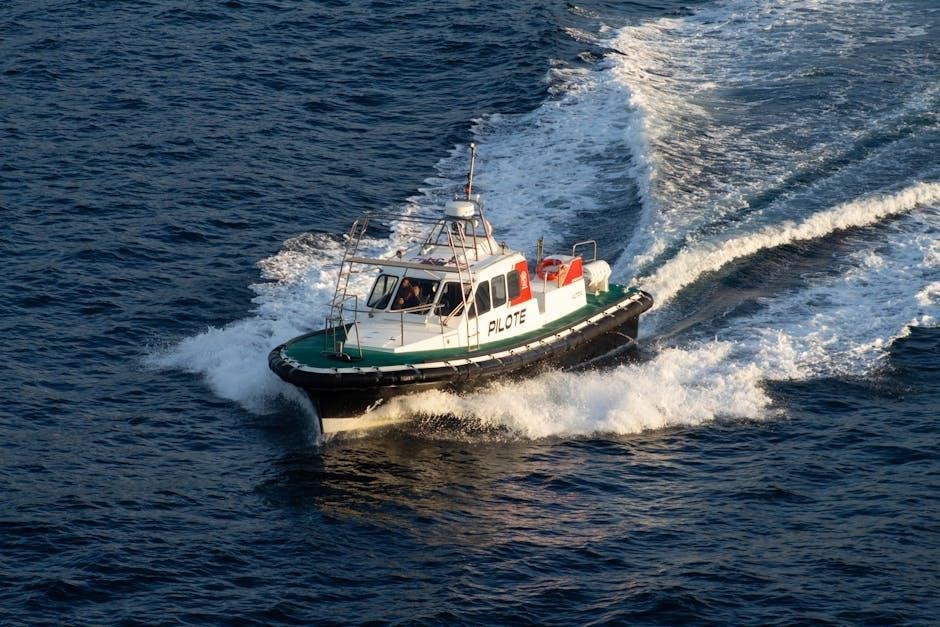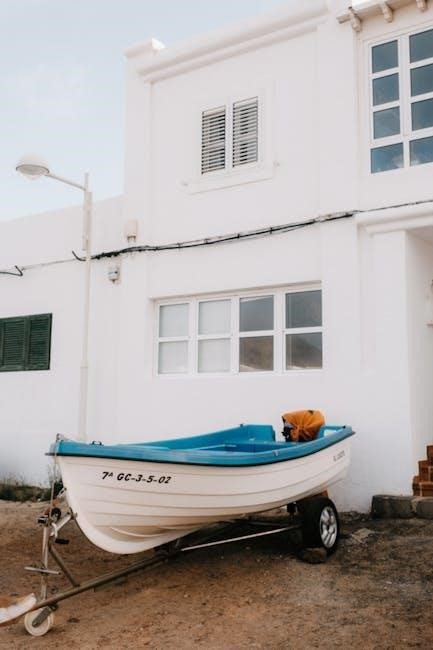Boat trailer guide-ons are essential accessories designed to simplify the often challenging task of loading and unloading a boat onto a trailer, providing visual cues and structural support to ensure proper alignment, enhancing safety and convenience.

What are Boat Trailer Guide-Ons?
Boat trailer guide-ons are aftermarket accessories designed to assist boaters in loading their boats onto trailers, especially in challenging conditions like low light or strong currents. These devices act as visual aids and physical guides, ensuring the boat aligns correctly with the trailer bunks or rollers. Typically mounted on the trailer frame, guide-ons extend upwards, creating a defined path for the boat to follow.
They are particularly useful for solo boaters or those with limited experience, reducing the risk of misalignment and potential damage to the boat or trailer. By providing a clear target, guide-ons streamline the loading process, making it faster, safer, and less stressful.

Types of Boat Trailer Guide-Ons
Boat trailer guide-ons come in various styles, including post-style, bunk, and roller guide-ons. Each type offers unique benefits depending on the boat size, trailer configuration, and typical launching conditions experienced by the user.
Post-Style Guide-Ons
Post-style guide-ons are among the most common types, featuring vertical posts typically made of PVC or metal that extend upwards from the trailer frame. These posts provide a clear visual reference, especially when the trailer is submerged, aiding boat alignment during loading. The posts guide the boat onto the trailer, preventing it from veering off course. They are particularly helpful in windy conditions or when dealing with strong currents. Often, these post-style guide-ons can be fitted with lights for enhanced visibility during nighttime or low-light conditions. Their simple design makes them relatively easy to install, and they are suitable for various boat and trailer sizes, offering a versatile solution for many boaters.
Bunk Guide-Ons
Bunk guide-ons are designed to assist in centering the boat on the trailer by providing carpeted or padded surfaces that the boat rests against as it’s being loaded. These guides help to align the boat correctly onto the trailer bunks, ensuring even weight distribution and preventing damage to the hull. Bunk guide-ons are especially beneficial for boats with flatter hulls, as they offer a wider contact area for guidance. They are typically mounted to the trailer frame and can be adjusted to accommodate different boat widths. Some models also feature adjustable heights, allowing for fine-tuning to match the boat’s specific dimensions. These guides simplify the loading process, reducing the risk of misalignment and making the task easier, particularly in challenging conditions.
Roller Guide-Ons
Roller guide-ons feature a series of rollers that help to center the boat as it is driven onto the trailer. These rollers minimize friction, making it easier to load and unload the boat, especially in shallow water or when dealing with strong currents. Roller guide-ons are particularly well-suited for boats with deeper V-hulls, as the rollers conform to the hull shape, providing smooth and consistent guidance. They are generally made from durable materials such as polyurethane or rubber to withstand the harsh marine environment. Installation typically involves mounting the guide-ons to the trailer frame and adjusting the roller height to align with the boat’s hull. Roller systems require minimal maintenance, but the rollers should be inspected periodically for wear and tear and replaced as needed to ensure optimal performance and prevent damage to the boat.

Benefits of Using Boat Trailer Guide-Ons
Boat trailer guide-ons offer numerous benefits, including simplifying boat loading and unloading, protecting your boat from damage during the process, and enhancing the overall visibility of your trailer for safer maneuvering.
Simplifying Boat Loading and Unloading
Boat trailer guide-ons drastically simplify the boat loading and unloading process, especially in challenging conditions. By providing a clear visual reference, guide-ons eliminate the guesswork involved in aligning the boat with the trailer. This is particularly helpful when dealing with strong currents, wind, or murky water, where visibility is limited. Guide-ons act as a boundary, preventing the boat from drifting too far to either side and ensuring it smoothly glides onto the trailer bunks or rollers.
This streamlined process saves time, reduces stress, and minimizes the risk of damage to both the boat and the trailer. With guide-ons, even novice boaters can confidently load and unload their vessels, making boating more accessible and enjoyable.
Protecting Your Boat
Boat trailer guide-ons play a crucial role in protecting your boat from potential damage during the loading and unloading process. Without guide-ons, there’s a higher risk of the boat scraping against the trailer, dock, or other objects, leading to scratches, dents, and even more significant structural damage. Guide-ons act as a buffer, guiding the boat safely onto the trailer and preventing direct contact with potentially abrasive surfaces.
They ensure the boat is properly centered on the trailer, reducing the likelihood of uneven weight distribution that can stress the hull. This protection extends the lifespan of your boat, preserving its value and appearance. By investing in guide-ons, boat owners gain peace of mind knowing their vessel is shielded from unnecessary wear and tear during trailering.
Improving Trailer Visibility
Boat trailer guide-ons significantly enhance trailer visibility, particularly when the trailer is submerged or partially submerged during launch and retrieval. The guide-ons, especially those with reflective materials or integrated lights, act as visual markers, allowing the boat operator to accurately position the boat relative to the trailer, even in murky or low-light conditions.
Improved visibility reduces the risk of misaligning the boat, preventing potential collisions with the trailer frame or other obstacles. This is particularly beneficial in crowded boat ramps or when dealing with challenging water conditions. Moreover, guide-ons make it easier for others to see the trailer, promoting overall safety at the boat ramp and minimizing the chances of accidents involving other boaters or vehicles. The added visibility contributes to a smoother, more confident, and safer boating experience.

Factors to Consider When Choosing Guide-Ons
Selecting the right boat trailer guide-ons depends on several crucial factors, including boat size, trailer type, and typical water conditions. These considerations ensure optimal performance, durability, and ease of use.
Boat Size and Type
The dimensions and design of your boat significantly influence the type of guide-ons you should select. Larger boats require sturdier, taller guide-ons for adequate support and visibility. Jon boats might need simple guide-ons. Consider the hull shape; a deep-V hull benefits from wider guides. For pontoon boats, specialized bunk guides are recommended. Ensure the guide-ons can handle the boat’s weight and length. Overlooking these aspects can lead to improper alignment and potential damage during loading or unloading. The guide-ons must be compatible with your specific boat model to guarantee safe and efficient trailering, eliminating frustration and ensuring a smooth experience.
Trailer Type and Construction
The material and design of your trailer frame directly impact the installation and compatibility of boat trailer guide-ons. Trailers with I-beam frames may require specific mounting brackets compared to those with square or round frames. Ensure the guide-ons are compatible with your trailer’s width and height. The strength of the trailer frame determines the load capacity the guide-ons can handle; heavier boats necessitate robust trailer frames and guide-ons. Consider the trailer’s existing features like rollers or bunks, as guide-ons can complement or replace these. Always verify that the chosen guide-ons can be securely attached to your specific trailer construction, ensuring stability and preventing damage during transit and launch.
Water Conditions and Launch Ramp Characteristics
Consider the typical water conditions where you launch your boat. In areas with strong currents or waves, taller and more robust guide-ons are essential to maintain boat alignment during loading. The slope and surface of the launch ramp also play a crucial role. Steeper ramps may require guide-ons that extend further underwater to provide adequate guidance as the boat floats onto the trailer. Uneven or damaged ramps can cause the boat to list to one side, making proper guide-on alignment critical. If you frequently launch in shallow water, ensure the guide-ons do not extend too far below the trailer, preventing them from scraping the ramp. Evaluate how these factors will affect guide-on placement and durability.

Installation of Boat Trailer Guide-Ons
Installing boat trailer guide-ons involves careful measurements, secure mounting to the trailer frame, and precise alignment to ensure proper boat guidance, requiring attention to detail and the right tools.
Tools and Materials Needed
Successfully installing boat trailer guide-ons requires gathering the right tools and materials beforehand. Essential tools include a socket wrench set, adjustable wrench, measuring tape, drill with various drill bits, and a level to ensure proper alignment. You’ll also need a marker or pencil for marking drilling locations.
Materials required encompass the boat trailer guide-on kit itself, U-bolts or mounting brackets compatible with your trailer frame, stainless steel hardware (nuts, bolts, washers) for corrosion resistance, and possibly a rust-preventative coating for exposed metal surfaces. Safety glasses and work gloves are crucial for protection during the installation process, ensuring a safe and efficient experience.
Step-by-Step Installation Guide
Begin by carefully reading the guide-on manufacturer’s instructions. Next, position the guide-ons on the trailer frame, determining the ideal location for your boat. Use a measuring tape to ensure symmetrical placement on both sides. Mark the mounting points with a marker. Drill pilot holes at these locations, ensuring they are appropriately sized for your hardware.
Attach the guide-ons using U-bolts or mounting brackets, tightening the hardware securely with a wrench. Use a level to verify that the guide-ons are vertically aligned. Make any necessary adjustments before fully tightening all bolts. Double-check all connections to guarantee stability and proper function, ensuring a safe and reliable installation process.
Mounting on Different Trailer Frames
Mounting boat trailer guide-ons requires adapting to various frame designs, including box, C-channel, and tubular frames. For box frames, U-bolts offer a secure and straightforward attachment method, clamping around the frame’s perimeter. C-channel frames may necessitate mounting plates to provide a flat surface for the guide-on brackets. Tubular frames often require specialized clamps that conform to the rounded shape.
When drilling into any frame, exercise caution to avoid weakening its structural integrity. Always use appropriate drill bits and apply rust-resistant paint to any exposed metal. Ensure all mounting hardware is compatible with the frame material to prevent corrosion and maintain long-term durability and stability for safe boat trailering.

Maintenance and Care of Boat Trailer Guide-Ons
Regular maintenance of boat trailer guide-ons ensures longevity and optimal performance. Key practices include inspecting for damage, cleaning off debris, lubricating moving parts, and replacing worn components to maintain their effectiveness.
Regular Inspection
Regularly inspecting your boat trailer guide-ons is crucial for maintaining their functionality and ensuring safe boat loading and unloading. Begin by visually assessing the guide-ons for any signs of damage, such as cracks, bends, or rust. Pay close attention to the mounting points, checking for loose bolts or weakened connections. Examine the guide posts or bunks for wear and tear, looking for frayed edges or deteriorated materials. Ensure that all rollers spin freely without excessive friction. If you notice any issues, address them promptly to prevent further damage and maintain optimal performance. A consistent inspection routine will help you identify and resolve potential problems before they escalate, extending the lifespan of your guide-ons.
Cleaning and Lubrication
Maintaining the cleanliness and lubrication of your boat trailer guide-ons is essential for their smooth operation and longevity. Regularly rinse the guide-ons with fresh water to remove salt, dirt, and debris, especially after exposure to saltwater environments. Use a mild soap and a soft brush to gently scrub away stubborn grime. For guide-ons with rollers, apply a marine-grade lubricant to the rollers and axles to ensure they spin freely and prevent corrosion. Inspect the guide posts or bunks for any signs of wear or abrasion and apply a protective coating if necessary. Proper cleaning and lubrication will help prevent rust, reduce friction, and extend the lifespan of your boat trailer guide-ons, ensuring they perform optimally every time you launch or retrieve your boat.
Replacement of Worn Parts
Over time, the components of your boat trailer guide-ons may experience wear and tear due to constant exposure to water, sunlight, and the weight of your boat. Regularly inspect the guide-ons for signs of damage, such as cracks, bends, or corrosion. Pay close attention to the rollers, bunks, and mounting hardware, as these are the most susceptible to wear. If you notice any worn or damaged parts, it’s crucial to replace them promptly to maintain the functionality and safety of your guide-ons. Purchase replacement parts from a reputable supplier to ensure they are compatible with your guide-ons and meet quality standards. Replacing worn parts will prevent further damage and ensure that your boat trailer guide-ons continue to provide reliable support and guidance for your boat.

DIY Boat Trailer Guide-Ons
For budget-conscious boaters, DIY boat trailer guide-ons offer a cost-effective alternative to commercial options. These homemade solutions can be tailored to specific needs and trailer setups, using readily available materials.
Homemade Guide Post Ideas
Creating your own boat trailer guide posts can be a rewarding project, allowing for customization and cost savings; One popular idea involves using PVC pipes, known for their durability and resistance to water damage; These can be cut to the desired height and mounted onto the trailer frame using U-bolts or other suitable fasteners. For enhanced visibility, consider adding reflective tape or LED lights to the posts, especially if you frequently launch or retrieve your boat in low-light conditions. Another approach involves repurposing materials such as metal conduit or even wooden posts, ensuring they are properly treated to withstand the elements. Remember to prioritize safety and stability when designing and constructing your homemade guide posts.
Affordable DIY Solutions
For boaters seeking budget-friendly alternatives to commercially available guide-ons, several DIY solutions offer effective functionality without breaking the bank. One option is to utilize readily available materials like PVC pipes or lumber to construct guide posts, securing them to the trailer frame with U-bolts or clamps. Repurposing materials, such as old fence posts or metal tubing, can further reduce costs. To enhance visibility, consider adding reflective tape or inexpensive LED strip lights to the guide posts. Another approach involves creating simple bunk-style guides using treated lumber and carpet, providing a soft surface for the boat to rest against; When implementing DIY solutions, prioritize safety and ensure the guide-ons are securely attached to the trailer and capable of withstanding the forces exerted during loading and unloading. Always double-check measurements and use corrosion-resistant hardware to prolong the lifespan of your DIY guide-ons.

Troubleshooting Common Problems
Addressing issues like misalignment or impact damage is crucial for maintaining guide-on effectiveness. Regular inspections and timely repairs ensure continued safe and efficient boat loading and unloading procedures.
Misalignment Issues

One common problem with boat trailer guide-ons is misalignment, which can occur due to improper installation, wear and tear, or accidental impacts. Misalignment can make it difficult to load the boat straight onto the trailer, potentially causing damage to the boat or the trailer itself. To troubleshoot misalignment, start by visually inspecting the guide-ons to ensure they are properly aligned with each other and with the boat’s hull. Use a level to check that the guide-ons are vertical, and adjust them as needed to achieve proper alignment.
If the guide-ons are bent or damaged, they may need to be replaced. Additionally, check the trailer frame for any signs of damage or bending, as this can also contribute to misalignment issues. Regular maintenance and inspection can help prevent misalignment problems and ensure smooth boat loading and unloading.
Damage from Impact
Boat trailer guide-ons are often subjected to impacts from the boat during loading and unloading, as well as from other objects in the environment. These impacts can cause damage to the guide-ons, such as bending, cracking, or breaking. To address damage from impact, regularly inspect the guide-ons for any signs of wear or damage. If you notice any cracks or breaks, replace the guide-ons immediately to prevent further damage.
For bent guide-ons, you may be able to straighten them using a hammer and a block of wood, but be careful not to damage the finish or weaken the metal. Consider adding padding or bumpers to the guide-ons to absorb impacts and protect them from damage. Reinforcing the guide-ons with additional supports can also help to increase their resistance to impact.
Boat trailer guide-ons are indispensable tools for any boat owner seeking to simplify and secure the boat loading and unloading process. From post-style to bunk and roller guide-ons, a variety of options exist to cater to different boat types, trailer configurations, and water conditions. Proper selection, installation, and maintenance of guide-ons are crucial for maximizing their benefits, including enhanced safety, boat protection, and improved visibility.
Whether opting for a DIY approach or purchasing pre-made guide-ons, boaters can significantly enhance their trailering experience by investing in these valuable accessories. By carefully considering factors such as boat size, trailer type, and launch ramp characteristics, boaters can choose the ideal guide-ons to meet their specific needs, ensuring smooth and stress-free boating adventures.
